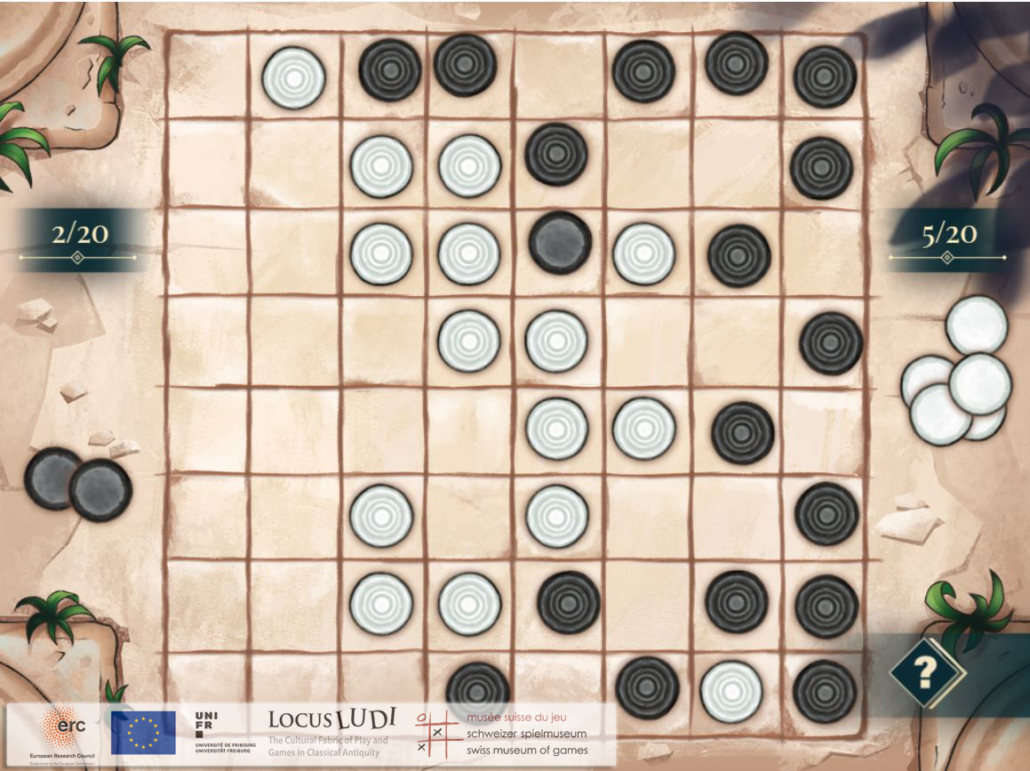Introduction
Wherever we go to explain ancient Greek and Roman games to a wider audience, people ask that question: How are these games played? As obvious this question is, as difficult it is to answer. Simply because rules of ancient board games have not come down to us. However, what we have got are archaeological finds of gaming material such as boards, dice and counters, representations of people playing games in painting, sculpture and mosaic as well as some allusions to games in ancient Greek and Roman literature. By uniting all this evidence and checking it against what we know about similar games played around the world, we can paint a fairly good picture of how Greek and Roman board games were played. Of course, it is impossible to reconstruct lost rules exactly, also because they certainly changed over time or varied from one region to another. But we can in some sort invent a game based on what we know about them and filling the gaps with plausible assumptions. This is what we did for the four ancient board games of which sufficient information is available: the Greek game of “Five Lines”, the Roman games “Latrunculi” and “XII Scripta” and “Three Men’s Morris”, the only ancient board game still played today. As a difference to other attempts to reconstruct the rules of ancient board games one may find here and there, our rules are based on scientific archaeological, philological and anthropological evidence.
Ulrich Schädler
To play against AI: please use SAFARI
ABACUS
NEW : Test counting on a Greek abacus ! and compare with Pente grammai
Reckoning means playing…
 …then test the Pente Grammai game
…then test the Pente Grammai game
More about: Look at Palamedes’ inventions
And visit the exhibition at the Swiss Museum of Games, La Tour-de-Peilz (10.02.2024- 06.01.2025)
PENTE GRAMMAI
The game of «five lines» is the oldest Greek board game we know. It was much appreciated among the Greeks at least from the 7thcentury BCE on. In Archaic times one imagined that the Greek heroes Ajax and Achilles played that game during the siege of Troy. Apart from the basic game played with five counters on a board with 5 parallel lines, enlarged versions with more lines as well as a double sized version with 11 lines existed. It seems that the game was still played in Roman times on a modified board with the lines replaced by squares.
XII SCRIPTA / ALEA
The “Game of 12 points” counts among the predecessors of modern Backgammon. It was highly appreciated in Roman times and popular even in the Late Antique and Early Byzantine periods. Whether or not the Greeks already knew the game, we cannot be sure of. It seems that during the centuries the rules of the game were modified several times as well as the name: Instead of playing with two dice a third one was added, and finally the track was shortened from 36 to 24 squares resulting in the modern Backgammon board.
ASTRAGALOI
LATRUNCULI
The “Game of little soldiers” is the only Roman strategic board game, of which information has come down to us. It is similar if not identical to the Greek “City” game. Several game boards for this type of game are preserved, with the numbers of squares ranging from 7×8 to 11×12 and perhaps even more squares. Therefore, the game complexity varied according to the smaller or bigger boards. Some more detailed descriptions in Roman literature make it possible to propose an interesting set of rules.
THREE MEN’S MORRIS
Three men’s morris is the only Roman game that survived Antiquity without any modification. Therefore, we know the exact rules, although we do not know its Latin name. For a long time, the numerous “wheel” patterns scratched into the floors of Roman towns were taken as a circular version of the game. However, recent studies have shown that this is a misleading interpretation, so that the presumed “round smaller merels” probably never existed.
Boardgames to download and print
Download and print out the boardgame models of each game and follow the icons: the panther for Greek games and the rooster for Roman games (Design: Alessandro Pace/ERC Locus Ludi)
With dice (1, 2 or 3)
- Pente grammai Greek version (5 lines): coloured | uncoloured

- Pente grammai Roman version (5 squares): coloured | uncoloured
- XII Scripta / Alea (Zenon): coloured | uncoloured
Without dice
- Polis (Greek): coloured | uncoloured / Ludus Latrunculorum (Roman): coloured | uncoloured
- Three men’s morris (version 1): coloured | uncoloured
- Three men’s morris (version 2): coloured | uncoloured
The animal drawings can also be downloaded separately, printed and coloured (Design: Alessandro Pace/ERC Locus Ludi)
- Panther: coloured | uncoloured

- Rooster: coloured | uncoloured










